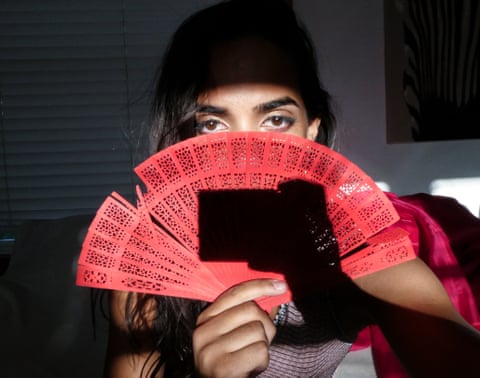Through Positive Eyes, a travelling exhibition of photos and stories by people living with HIV and Aids and curated by the UCLA Art & Global Health Center, was originally scheduled to open at the Bill & Melinda Gates Foundation Discovery Center in the summer of 2020. Starting with an intensive 10-day workshop, the training was intended to support a group of HIV-positive people in learning how to share their stories and photographic images to confront the stigma associated with the illness.
Due to Covid-19, the expected workshop had to be reconsidered and transformed to a virtual setting. The result was an extended five-month version of the group workshop, augmented by individual sessions, during which the cohort bonded as a collective, considered various aspects of their HIV stories, and developed unique visual approaches and individual photographic voices for the virtual format.
“The results have exceeded our expectations,” said Gideon Mendel, co-director of the Through Positive Eyes project. “An amazingly rich and diverse set of images has emerged, both creatively astonishing and politically powerful. This moment, when we are all so concerned about the Covid virus, reminds us of the continued challenges that people living with the HIV virus are still facing around the world.”
The original intention was for the photo-stories to be presented live in the galleries of the Gates Foundation Discovery Center for school and community groups and for members of the public.
With the temporary closure of all museum spaces in Seattle in spring of 2020, these Banishing Stigma presentations have been moved online. Groups and especially school groups from anywhere in the world are able to sign up by visiting the Discovery Center’s website.

Julene
We long-term survivors, the first cohort of people with HIV/Aids, live on full alert. We received our diagnosis before the cocktail approach, before protease inhibitors were approved in 1996. We were told we would die.
After my diagnosis in 1989, when I was 37 years old, I thought I might replicate my father’s early death, at age 46. Was this my fate? Now, at 68, I’m still here. I attribute my survival to refusing to believe that anyone could predict my death date. I knew the only medication available at the time, AZT, was a death sentence, so I avoided that early ineffective treatment and instead bolstered my immune system with alternative ways of healing. For my healing, I gave myself permission to grieve, to hope, and to love.
The early years were all about grief. I enrolled in a Master’s program for counselling and started to work at the largest Aids service organisation in the north-west. As a case manager, my grief list grew: coworkers died. Friends died. Clients died. I threw myself into this work filled with loss. I did the work out of love, feeling compassion and empathy for the many young men dying of Aids. In my off time I went to movies about Aids, read books about Aids, at work we had T-shirts that had 24/7 stamped on them. It was hard to separate. My whole life was centred on Aids.
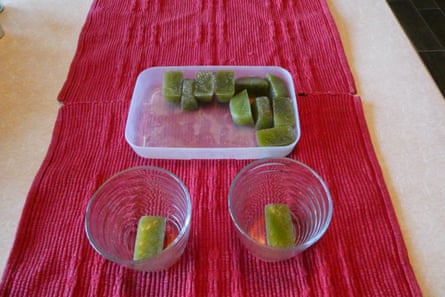

Attending a workshop with Ryan Drum, a brilliant herbalist and a storyteller, I gathered my courage to tell him my status and asked him what I could do to protect myself. He said a doctor in Vancouver, BC, treated HIV with subdermal St John’s Wort oil, made from a common flowering plant. I asked him how to use it. His answer: rub the oil on the inside of my arms or thighs. St John’s Wort was my first remedy. At first I bought the oil, then I found the plant and made my own infused oil and tincture, which I learned to do with many plants.

Those early years, I intentionally thought of my body as an experiment and dedicated myself to preventative health. Herbal knowledge helped me learn how to fortify myself. My goals were to keep the microbiome in my gut as strong as possible, and to tone and strengthen my system. I put off taking western medications for 13 years, which allowed me to avoid the awful side effects I saw so many others experience.
I did my work with Aids service organizations out of love for 21 years. If I had not had my partner, I don’t know if I could have done the work for that long. Love with deep connection is a precious gift, especially when we’ve met the person who sparks joy in our heart, which is what I felt on meeting my partner. He is HIV-negative and he made the decision to stay with me after I was diagnosed. He is my strongest ally and supporter.
We don’t drink alcohol, but we still toast each other. Our newest remedy is celery juice cocktails. “To a long life!”

Edward
I was born to a mother who couldn’t take care of my brother, sister and I, so we went into the foster care system when I was three. I ended up getting adopted the day after my sixth birthday in 1997. The people who decided “hey, we want you” were white.
We moved to a farm about 25 minutes outside of Spokane, Washington. Unfortunately, as I grew up, I found my new home came with a lot of problems. You can only imagine trying to run a house of 15 kids. I was the middle child in an even bigger family. I went from having a mother who couldn’t take care of me to a mother who showed no interest in me.
At age 12 or 13, I learned about HIV in school and Ryan White, the kid in Indiana who contracted the virus through a blood transfusion, got kicked out of school, then took his case to the supreme court. For some reason I was super curious about this virus because since I could remember, I had been taking medication and didn’t know why. So, I went home and asked my mother if I had it. She said no.
Then, not even a week later, she asked me if I wanted a bike and called me into the van. Not five seconds go by before she says to me: “Do you remember that question you asked?” And of course, I remembered. “Well you are HIV positive. You were born with it.” I got the bike. A blue mountain bike. I loved it and hated it. It wasn’t because she loved me but because she felt sorry for me that she bought me this present. To me it was like she was trying to put a band-aid over a bullet hole. An attempt to cover up the fact that I have what once was considered a life-threatening disease. I no longer wanted that bike or to ever please my mom again. It was a moment that I will never forget.


And just like that my life changed dramatically. Not only do I not live with my birth parents anymore. Now I know I am HIV positive.
So much has happened in my life since that day. I graduated from high school, left my foster parents’ home, struggled with many forms of stigma, worked construction, went to college, discovered a passion for acting, and have done the best I can to live authentically. I have also learned to be OK with everything I’ve gone through. I’m choosing to not let my past break me. Each one of us can choose the stories we tell and what we can offer to the world. We need stories to let us know it’s OK to be us and that we are worthy. Those are the stories I want to tell. I want the world to know that the things we see as uncommon in each other can also be what makes us beautiful.

Hugo
Lately I’ve been thinking a lot about stigma and what it means to live under its shadow. Stigma for a boy is not acting like one. Stigma for a citizen is wanting to abandon one’s homeland, for an immigrant is not speaking the language, for an artist is not thinking rationally, for a queer individual is not adhering to society’s gender roles, for a senior it’s not acting your age. Thinking about death is stigmatised, so is feeling envy, rage, believing or not believing in God – the list goes on and on.
In order to soothe the pain of living with all these stigmas, I see now that I engaged in a whole set of self-destructive behaviours, which, in my understanding, is how I contracted HIV.
In the mid-1980s, just a few years into the Aids epidemic, I had an epiphany.
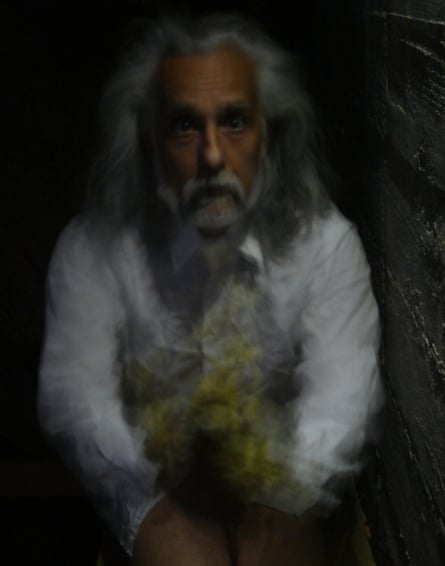
I realized that Aids wasn’t just affecting old leather queens in New York’s West Village. It was beginning to kill people like me, in my rebellious and unconventional community on the Lower East side of Manhattan, people who were making art, running galleries, and performing in drag. In 1987, I got sober and tested positive. And I was fortunate to find a doctor who helped me make the right choices.
In 1992, by [a] hospital bed, I feel a membrane outside of the window. It separates and facilitates passage between realms.
Sometime later, I too became truly sick and felt that my life was coming to an end. Outside my window the lofty statues of seers, poets, and kings that adorn the museum fade away as the motorized gurgling from the aerosol nebulizer, and the breezes from Prospect Park carrying the aroma of lilacs lull me to sleep. I had arranged to have the most beautiful death.
Today I am living on the grounds once occupied by a mansion that death built, put up by an enterprising young white man who followed others who travelled west, raining destruction on the first people. Upon arriving he set up shop to offer all-inclusive funeral package-deals to his fellow travellers. A new building occupies the Olympian site today, but all of those ghosts are still among us and within us, they live in the rubble of the mansion, which lies broken and scattered on the slope, helping to shore up the foundations of my home, from where I have the most lovely view of the stolen land where I’m living in stolen time.
Why is this part of my stigma story, you ask?
Because queer people are a type of first people that society carries with them to alleviate their self-hate and fears. They hunt us down, murder, and maim, abuse and denigrate, and always deny us from weaving into our tapestry society’s dignified rituals: births, weddings, graduations, and the occasional funeral, but always, always, deny entry into their precious heaven. My fellow ghosts and I push back.
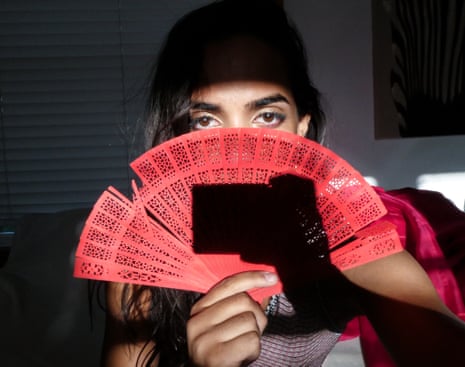
CL
The word immunity comes from the latin root Immunis which means: “Freed from public service or charge.” This is the true immunity lost by the human immunodeficiency virus, the ability to live a life without being an educator, an activist, and a carrier of painful knowledge. This could also be said about my current identity as a trans woman. I am constantly educating people on gender, pharmaceuticals, the tenets of transmission, and teaching people that it’s normal to be trans-attracted, that murdering us won’t make those feelings go away. I am an educator in order to survive physically and to endure spiritually, but this isn’t my only method of survival.
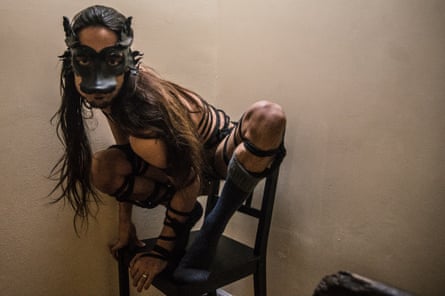
To live with the psychological effects of chronic illness, specifically HIV, I have experimented with a variety of coping mechanisms: tattooing, rope bondage, art therapy, and specific substances, namely ketamine, are ways that I combat alexithymia. Basically, that’s a fancy word for a collection of dissociative behaviours in adults or children.
When I am particularly stressed, I tattoo my body as a cathartic blood-letting ritual, a ritual of self-harm. It is equally one of self-care, and for me a form of harm-reduction. Rope bondage, also known as shibari or kinbaku in Japan, serves as a deep pressure therapy to help place my center of awareness back into my body. Art has long been studied for its healing effects on integrating painful memories and flashbacks deep within the traumatized mind. I primarily paint and play piano to find out how I’m feeling.
I am so preoccupied with the effects of trauma because it has had a major impact on my life. It has delayed my debut with hormone replacement therapy, with beginning my transformation, with feeling alive. In the end, the ultimate truth is I am a woman and I deserve a chance at feminine work, at feminine joy.
I am worth the struggle it takes to live an honest life; my mental health is work but it’s a labor of love. I want to make the world aware of the psychosocial effects of oppression, and to use that knowledge to perform radical compassion. In showing self-kindness and tending to our emotional needs we are performing a radical act of resistance. By finding the strength of spirit to stop hiding and sharing my journey and pains, maybe a version of transcendent love will begin to find me and I will find a home in my body, where HIV doesn’t rule the roost. Perhaps with patience and gentleness I can summon the family I’ve always wanted and finally resolve that I don’t really need to be clean to be free.

Bill
The story of my life, sadly, is not a unique one in Native American culture. This story can be told in a thousand different ways, each story representing a person who suffered the same upbringing I did as a child, expressing deep emotional and mental scars, and insurmountable pain. The trauma that we suffered was our being taken away from our families when we were young, and placed in government boarding schools. I was nine years old when my sister and I were taken. Needless to say, my life became a vicious cycle of depression, failure, and loss. How could anyone who didn’t know who they were succeed? It wasn’t until I became HIV positive in 1986 did my life begin to change.
My journey to becoming an advocate for the Native American community on HIV, I have come to believe, was by design. I started by volunteering for various Aids organizations, which led to my joining community advisory boards, which exposed me to a vast education on Aids, research, and how services for people living with Aids came into being. Through my involvement with these groups, I came to realize that the reason Native Americans were the most underserved community with regard to HIV, was that no one was speaking up. This bothered me, and when Defeat HIV, a group I was involved with, asked me to approach the Seattle Indian Health Board to let us come and do a presentation on cure research for HIV, I saw just how strong stigma on HIV was in Native Country.

It took three years, and the hiring of a new executive director, who was very pro-Aids advocacy, for us to get our break. It was during the planning of our first event that God began to tug at my heart to step up and take on the role of advocate. No matter what excuses I came up with, the tugging never stopped.
I had heard about these three Native women who contracted HIV, and they were so ashamed and frightened that if anyone found out, they would be disowned not only by their communities, but from their families as well, that they never sought treatment, and because of this, they died. When I heard about the first one, I thought: “That’s sad.” Later, when I heard about the second, it gave me pause. When I heard about the third, it stunned me. I sat for a long period of time thinking about the fears and anxieties that these women lived through, and having lived through them myself, I knew how paralyzing those fears could be. It was these women that I was thinking about as we were finalizing the agenda for our event, and just as we were about to wrap up the meeting, I anxiously thought: “This is it, it’s now or never,” and I blurted out: “I want to do the welcome,” and with that, I stepped into the light.
The Through Positive Eyes project began in 2008. Since then, workshops involving more than 150 HIV-positive people have been offered in major cities around the world. For more information on the project visit ThroughPositiveEyes.org.
